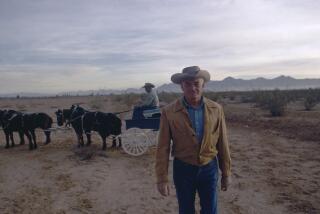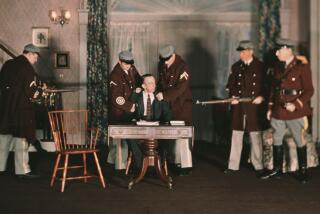The Allegory of the Yellow Brick Road
- Share via
“The Wizard of Oz” a political parable? A look at the characters at the time L. Frank Baum wrote (1900) indicates many parallels between the novel and the issues of the day--at least according to a 1964 interpretation by Henry M. Littlefield, a Mount Vernon, N.Y., high school teacher.
The Scarecrow represents the Kansas farmer, made to feel dumb by the great Midwestern drought of the 1890s and low crop prices caused by a shortage in the money supply, Littlefield wrote.
At the time, Uncle Sam banked on the “gold standard.” For farmers, “free silver” became a popular slogan and the dominant issue in William Jennings Bryan’s 1896 and 1900 campaigns for President.
But what did the farmer know about banking? Newspaper cartoonists portrayed him as the scarecrow: “If I only had a brain.”
The Tin Woodsman was the victim of a “curse” cast by the Witch of the East. Her spell dehumanized labor; when he swung his ax, he chopped off a limb. The faster and better he worked, the more he became like a machine. “If I only had a heart.”
The Cowardly Lion’s great roar was heard throughout the Land of Oz, like Bryan’s powerful “Cross of Gold” speech delivered at the 1896 Democratic convention. Bryan lost the elections. The candidate, like the Cowardly Lion, could roar but not win a fight. “If I only had the nerve.”
Dorothy brings these three together. She is Miss Everyperson, blessed with the kiss of the Good Witch of the North, and wearing the charmed “silver shoes.” They go to see the “great and powerful Wizard of Oz” but he is a bumbler; he only has power because people believe he has power. He is able to be everything to everybody, much like President William McKinley in Baum’s day, and Ronald Reagan today.
Is it coincidence that the Wicked Witch of the West, who threatens the Scarecrow--the farmer--with fire, should be killed by water? Bring rain to Kansas and the farmer profits. Baum’s witches portray evil in popular forms--drought to the farmer, boss to the laborer, fear in the voice of the people.
These characterizations alone don’t make a parable, but Baum’s subtle, specious metaphor does. When Dorothy begins her walk to the Emerald City, Baum describes “her silver shoes, tinkling merrily on the hard, yellow roadbed.” Metal on metal, silver on gold.
Littlefield wrote, “The allegory is abundantly clear.” Silver represented valid power in a land of make-believe, just as the gold did on Wall Street.
There’s no mystery in Baum’s Land of Oz--Big O little z, the abbreviation for ounce. The silver shoes had the power, all Dorothy had to do was believe.
Baum sought to write stories that would “bear the stamp of our times and depict the progressive fairies” of government. He created a fairy tale with a symbolic Populist allegory.
Just remember when Dorothy returns to “Oz” with the witch’s broom; she learns that the Wizard is a meek, little man.
“Are you not a great Wizard?” she asks.
The Wizard replies: “I have been making believe.”
More to Read
Sign up for Essential California
The most important California stories and recommendations in your inbox every morning.
You may occasionally receive promotional content from the Los Angeles Times.












